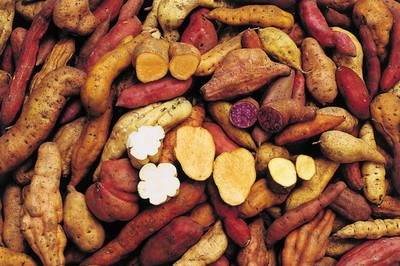Sweetpotato Facts and Figures
Sweetpotato (Ipomoea batatas) belongs to the morning-glory family. In spite of its name, it is not related to the potato. Unlike the potato – which is a tuber, or thickened stem – the sweetpotato is a storage root. Despite a physical similarity, yams are not related either.
Worldwide, sweetpotato is the sixth most important food crop after rice, wheat, potatoes, maize and cassava. But in developing countries, it is the fifth most important food crop. More than 105 million metric tons are produced globally each year; 95% of which are grown in developing countries.
Sweetpotato can grow at altitudes ranging from sea level to 2,500 meters. It requires fewer inputs and less labor than other crops such as maize, and tolerates marginal growing conditions (e.g., dry spells, poor soil).
Sweetpotato comes in varieties with skin and flesh color that range from white to yellow, orange, and deep purple. Orange-fleshed sweetpotato is an important source of beta-carotene, the precursor to Vitamin A. Just 125g of fresh sweetpotato roots from most orange-fleshed varieties contain enough beta-carotene to provide the daily pro-vitamin A needs of a preschooler.

Sweetpotato is also a valuable source of vitamins B, C, and E, and it contains moderate levels of iron and zinc.
Nutritionists in the USA are exploring the potential cancer preventing properties of the anthocyanins, which are present in purple-fleshed sweetpotato.
Though its origins lie in Latin America, Asia is now the largest sweetpotato-producing region in the world, with figures showing over 90 million tons produced annually. China is the world’s biggest producer and consumer of sweetpotato, where it is used for food, animal feed, and processing (as food, starch, and other products).
The importance of sweetpotato as a food crop is growing rapidly in some parts of the world. In Sub-Saharan Africa, it is outpacing the growth rate of other staples.
Sweetpotato is used for both human consumption and as a healthy, cheap source of animal feed. Recent studies suggest that animals fed on high protein sweetpotato vines produce less methane gas than with other feed, potentially contributing an important reduction in harmful global emissions.
Sweetpotato has a long history as a life saver. The Japanese used it when typhoons demolished their rice fields. It kept millions from starvation in famine-plagued China in the early 1960’s and came to the rescue in Uganda in the 1990’s, when a virus ravaged cassava crops.
